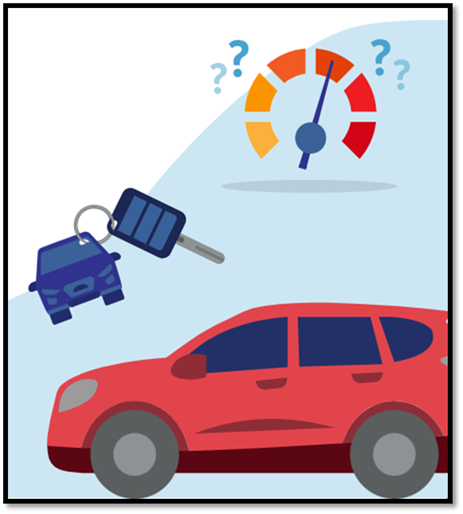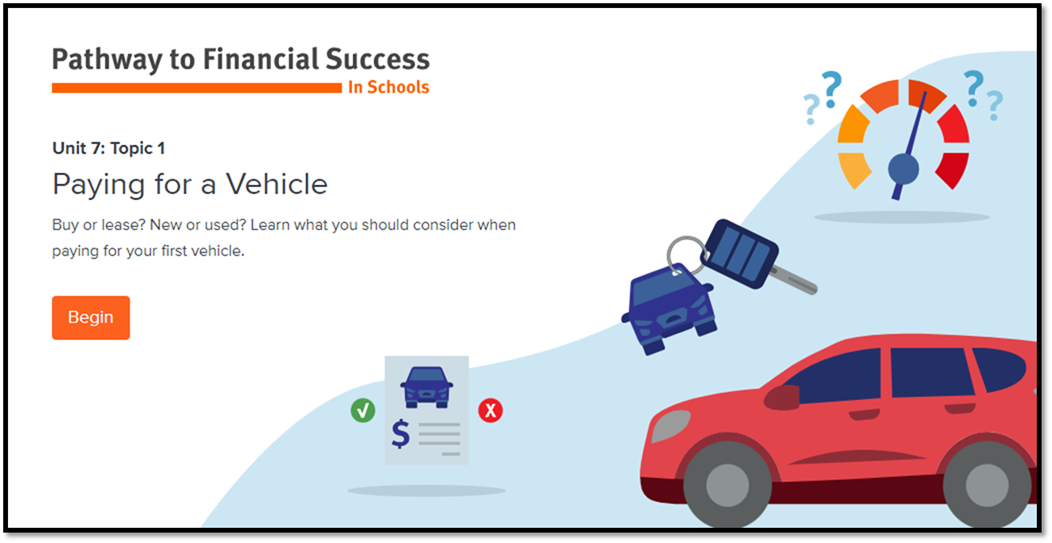Paying
for a Vehicle

Unit Overview
Should you get a used or new vehicle? What’s the difference
between leasing and buying a vehicle? In this module, students learn about paying
for a vehicle. The module begins with students determining various car-buying factors’
importance to them. Students learn what factors impact costs, including whether
the vehicle is new or used. They explore the basics of buying a vehicle and
contrast that to leasing. Students also learn that there are ongoing costs
associated with having a vehicle.
Paying for a Vehicle
Below are three questions to think about when paying for a
vehicle.
·
Do
you plan to have a vehicle someday? If so, how many years away do you think
your first purchase will be?
·
Do
you know anyone that has bought or leased a vehicle recently? Do you know what
factors they considered?
·
What
would matter most to you when selecting a new vehicle?
Click on the image below to complete the learning module
“Pathway to Financial Success.”
Vocabulary
Down Payment: A down payment refers to the initial sum of money a buyer
pays upfront when purchasing a big-ticket item, such as a car or a house. In
the context of car financing, it is the cash amount paid at the time of
purchase, reducing the total loan amount needed. A substantial down payment can
lower monthly loan payments and may lead to more favorable loan terms,
including lower interest rates.
Collateral Amount: The collateral amount is the value of an asset or property
pledged as security for a loan. In the context of car loans, the vehicle being
purchased serves as collateral. If the borrower defaults on the loan, the
lender can seize and sell the car to recover the outstanding debt. The
collateral amount helps mitigate the lender's risk and allows borrowers to secure
loans with better terms and lower interest rates.
Insurance: Insurance is a protective financial product that provides
coverage and financial compensation in the event of specified losses or
damages. In the context of car ownership, car insurance offers protection
against accidents, theft, and other incidents. It also includes liability
coverage for bodily injury or property damage caused to others. Car insurance
is a legal requirement in many jurisdictions and is essential for protecting
both the driver and the vehicle from unforeseen risks.
Gas and Maintenance: Gas and maintenance costs are ongoing expenses for owning
and operating a vehicle. Gas costs cover the price of fuel needed to power the
car, while maintenance expenses include routine services, repairs, and
replacements of car components to keep the vehicle in good working condition.
These costs are essential to consider when budgeting for car ownership, as they
can significantly impact the overall cost of owning a vehicle.
Monthly Payment: The monthly payment refers to the fixed amount that a borrower
must pay each month to repay a loan, such as a car loan, over a predetermined
period. It includes both the principal amount borrowed and the accrued
interest. The monthly payment amount is calculated based on the loan term,
interest rate, and the total amount borrowed. Understanding the monthly payment
is crucial for budgeting and ensuring the loan is manageable within one's
financial capacity.
Loan Origination Fee: A loan origination fee is a one-time charge levied by
lenders to cover the cost of processing and approving a loan application. It is
typically a percentage of the total loan amount and is charged at the time the
loan is originated. The fee compensates the lender for administrative expenses,
credit checks, and underwriting services. Borrowers should factor in this fee
when assessing the total cost of the loan and determining the most
cost-effective financing option.
Foundations of Finance
Anytime you borrow money in the form of a loan, you are responsible
for paying back the amount you borrowed and any fees.
Fees are called interest.
Click on the image below to complete the learning module
“Pathway to Financial Success.”
Complete Sections 1 and 2 in the learning module.
|
Below are additional educational resources and activities for this unit. |
|
|
|
|
|
|

